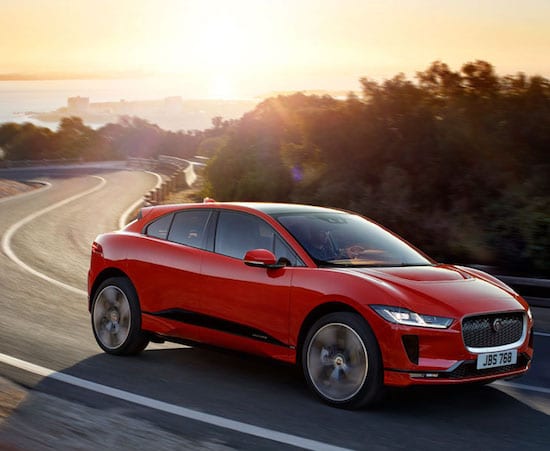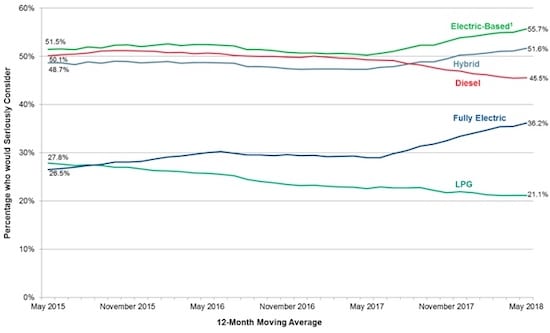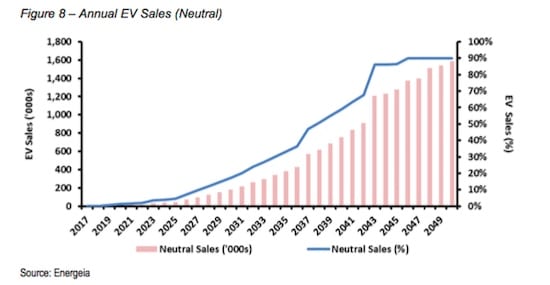Almost two-thirds of Aussies could own an electric vehicle within 10 years, predicts luxury car maker Jaguar, a figure that is significantly more bullish about the uptake of EVs than other analysis.
Jaguar commissioned a survey as part of its ‘Driving Australia Forward’ report, the findings of which indicates that one in five Australians of driving age think they will buy an electric car within the next two years.
That figure jumps to almost 84 per cent of buyers who say they’d like to own an EV at some point in their lives.
This is a very optimistic outlook considering that right now EVs represent something like 0.2 per cent of total sales, and a recently survey by Roy Morgan (see table below) suggests that only 55.7 per cent of Australians are seriously considering buying some form of electrified vehicle.
Other forecasts such as Bloomberg New Energy Finance predict that 40 per cent of light vehicles will be electric by 2040, while the Australian Energy Market Operator recently doubled its forecast, predicting half of all cars would be electric by around the same time.
If Jaguar’s forecasts are correct, this means Australian car dealers could be selling an average of 1.2 million EV or PHEV cars per year over the next 10 years, around double what is anticipated by AEMO.
Who is going to buy all these electric vehicles?
According to Jaguar, the most likely buyer for an EV is a millennial male, with 43 per cent of millennial respondents saying they wanted an EV, compared to only 34 per cent of baby boomers.
Men were also more likely to want to purchase an EV as their next car, the survey found, at 42 per cent compared to 27 per cent of women. About 38 per cent of people surveyed said they wanted an EV “a lot”.
However, the cost of EVs remains a key factor, as Kevin Nicholls, marketing director at Jaguar Land Rover Australia admits.
“While Aussies clearly see the benefits of electric vehicles they’re still hesitant about the price – 75 per cent said that if electric vehicles cost the same as their petrol equivalent, it would be their next car purchase,” he says.
Australia is dragging some 10 years behind the rest of the world in electric vehicle uptake, many surveys suggest, largely because of a lack of EV policy and purchase incentives. Even when policies such as emissions standards are proposed, they are shouted down as a form of carbon tax.
In May, Jaguar called upon the Australian government to provide the local car industry with a clear path to follow to help boost the uptake of EVs.
“Australians are ready for electric vehicles, and the industry is too – now we need the federal government to do their bit and present their framework,” Nicholls told RenewEconomy.
Jaguar is about to introduce into Australia its electric i-Pace, which Nicholls says will be available in Jaguar dealerships in November this year. The luxury SUV has a starting price of around $119,000, plus on-road costs.
Many Australian consumers will wait for the arrival of more affordable models such as global bestseller Nissan Leaf, and similar models such as the Hyundai Ioniq and Kia Niro, and the Tesla Model 3.
But even cheaper models will be needed for a mass uptake. RE asked Jaguar if they had plans to bring out something to fit the budget of most Australians, but they declined to comment.
Jaguar did say, however, that education and public awareness were key factors in future purchases, with the number of people saying they would likely buy an EV jumping by 8 per cent after learning more about how good EVs can be for the environment.
Another report has suggested that the uptake of EVs in Australia is also hindered by dealers’ reluctance to sell them, often leaving electric vehicles completely out of sales pitches, due to lack of training for staff to sell them and because they will see reduced profits due to less maintenance and repairs for EVs.
AEMO’s newly released Integrated System Plan predicts a moderate uptake of electric vehicles in its core “neutral” scenario,” with 10 per cent of the vehicle fleet being electrified by 2030. It says at this level, vehicle charging is uncoordinated, and primarily occurs overnight.
That forecast – slow, neutral and fast – was based on forecasts prepared by Energeia.
The sensitivity of that modelling was highlighted in a report presented by the Clean Energy Finance Corp and the Australian Renewable Energy Agency, which suggested that with incentives, uptake would surge.
As this graph shows, the proportion of EVs in the overall fleet could jump to around 25 per cent by 2030, and near enough to 100 per cent by 2050, with the right incentive. Even moderate intervention would deliver more than 90 per cent by that date.
BloombergNEF predicts that around 40 per cent of sales will be electric by 2040, creating a significant “behind the motor” resource of battery storage that could be deployed for the electricity grid as well.
This uptake is likely to be accompanied by significant increases in rooftop solar and battery storage, and a shift to consumer-driven energy outcomes, rather than a grid dependent only on centralised assets.

Bridie Schmidt is associate editor for The Driven, sister site of Renew Economy. She has been writing about electric vehicles since 2018, and has a keen interest in the role that zero-emissions transport has to play in sustainability. She has participated in podcasts such as Download This Show with Marc Fennell and Shirtloads of Science with Karl Kruszelnicki and is co-organiser of the Northern Rivers Electric Vehicle Forum. Bridie also owns a Tesla Model Y and has it available for hire on evee.com.au.





